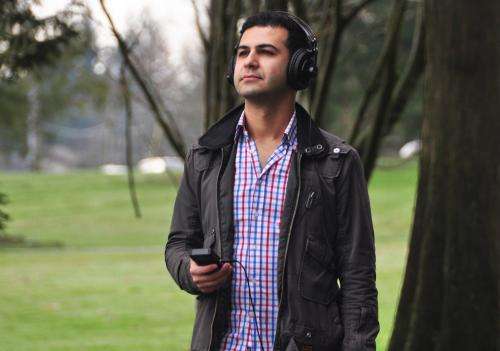Using sound to manage chronic pain

Women with chronic pain may be more sensitive to sounds than their male counterparts, researchers at Simon Fraser University have found.
The finding emerged as part of a study related to the therapeutic use of music for chronic pain (CP) patients. SFU lead researcher Mark Nazemi was comparing the sensitivity of chronic pain and healthy controls on a range of audio frequencies.
During the study, the auditory sensitivity of 41 subjects was measured; 23 of them were CP patients. Researchers found that chronic pain patients were more sensitive to sounds than the control group, but that the effect was substantially greater in women suffering from chronic pain.
"Female CP patients reported greater sensitivity to everyday environmental sounds," says Nazemi, who presented his findings at the European chapter of the International Association for the Study of Pain in Florence last month.
"This tells us that CP-specific acoustic therapies need to be developed. It also suggests that CP patients should be informed about the potential ill effects of loud environmental sounds, and about the possible negative effects of sound on their disorders," Nazemi adds.
A PhD student in SFU's School of Interactive Arts and Technology (SIAT), Nazemi is currently studying how to use an interactive sound system for therapy and is looking for sound properties that have therapeutic qualities for the body and mind.
Nazemi is a researcher in SFU Surrey's Pain Studies Lab, where he works with lab director Diane Gromala. A SIAT professor, Gromala is the founding director of the Chronic Pain Research Institute and holds a Canada Research Chair in Computational Technologies for Transforming Pain.
Nazemi is designing soundscape compositions based on "soundwalks"–natural sounds captured from a variety of environments. His aim is to provide patients in medical waiting rooms with access to the soundwalks via headphones to help lower anxiety and stress while they are waiting.
Influenced by soundscape research carried out decades ago by SFU professor emeritus Barry Truax, Nazemi is exploring whether these "listening treatments" may assist patients in more clearly communicating symptoms to their doctors, a project he is undertaking in collaboration with the Vancouver Arthritis Research Centre. He says preliminary results look positive.
This term Nazemi is teaching a pair of courses including one on interactive video. His students will present their art installations and interactive multimedia projects at Aberthau Mansion in Kitsilano on Nov. 29.
Nazemi is also founder of the Stylus College of Sound and Technology, which teaches music production and audio engineering.















